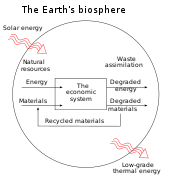Social metabolism
| Part of a series on |
| Ecological economics |
|---|
 |
Social metabolism or socioeconomic metabolism is the set of flows of materials and energy that occur between nature and society, between different societies, and within societies. These human-controlled material and energy flows are a basic feature of all societies but their magnitude and diversity largely depend on specific cultures, or sociometabolic regimes.[1][2] Social or socioeconomic metabolism is also described as "the
Social metabolic processes begin with the
Social metabolism represents an extension of the metabolism concept from biological organisms like human bodies to the biophysical basis of society. In
Society and its metabolism together form an autopoietic system, a complex system that reproduces itself. Neither culture nor social metabolism can reproduce themselves in isolation. Humans need food and shelter, which is delivered by social metabolism, and the latter needs humans to operate it.
Social or socioeconomic metabolism stipulates that human society and its interaction with nature form a complex self-reproducing system, and it can therefore be seen as paradigm for studying the biophysical basis of human societies under the aspect of self-reproduction. "A common paradigm can facilitate model combination and integration, which can lead to more robust and comprehensive interdisciplinary assessments of sustainable development strategies. ... The use of social or socioeconomic metabolism as paradigm can help to justify alternative economic concepts."[3]
Origins of the concept
The concept of social metabolism emerged in the
It was only in the late 1970s that the
Social metabolism as a proxy for human development[5]
The concept of social metabolism has been used in historical research as a framework to describe the development of human societies over time. Particularly important in this field is the work done by the German historian Rolf Sieferle on the socio-ecological patterns of societies. Focusing on the energy dimension of social metabolism (i.e. the energetic metabolism), Sieferle suggested that it is possible to classify different "socio-ecological patterns", or regimes, of human societies over time, according to the main source of energy and the dominant energy conversion technology that these use. Sieferle identified three main regimes that characterised human history: hunting-gathering, agrarian and industrial. The hunting-gathering regime relied on "passive solar energy utilization", as in this configuration humans relied mainly on products of recent photosynthesis, namely plants and animals for food and firewood for heat. This resulted in highly nomadic societies and low population density. Eventually, the Neolithic revolution allowed societies to switch to an agrarian regime based on "active solar energy utilization". Humans started to modify their environment more systematically through deforestation in order maximise the exploitation of land and sun for farming to produce food for humans and for livestock. This led to sedentary societies, increased human labour burden and to higher population growth, which in turn boosted the development of more structured social hierarchies and dynamics. Finally, the invention of the steam engine in the 16th century triggered the emergence of the industrial regime, that relies on fossil fuels as its main energy source. This led to the industrial socio-ecological pattern that regulates human society as we now it today.
Following Sieferle's footsteps, other social scientists eventually tried to reconstruct human history through social metabolism, also through quantitative analyses and indicators. Among them it is worth mentioning the Total Primary Energy Supply (TPES), the Domestic Energy Consumption (DEC), the Human Appropriation of Net Primary Production (HANPP) and others.
Using energetic metabolism as a proxy for human development has important implications not only for historical analysis, but also for the elaboration of future scenarios. According to many studies, peak fossil fuel (i.e. the maximum rate of fossil fuels extraction on a global scale) has already been reached or is likely to be reached soon. Understanding what will be the next main energy source and conversion technology of human societies in the future has important policy and societal implications.
Accounting Methods
Studies of social metabolism can be carried out at different levels of system aggregation, see
There are different schools of thought concerning social metabolism, each with its own accounting method. The two that can be identified have their roots in two different schools of research, the Material and Energy Flow Analyses (
While MEFA, primarily focusses its research on
See also
- Agroecology
- Anthropogenic metabolism
- Balance of nature
- Carbon rift
- Circular economy
- Degrowth
- Dematerialization (economics)
- Ecological economics
- Ecological footprint
- Energy crisis
- Energy economics
- Energy returned on energy invested
- Ecological civilization
- Earth jurisprudence
- Scale (analytical tool)
- Global hectare
- Industrial metabolism
- Land (economics)
- Material flow analysis
- Metabolic rift
- MuSIASEM
- Natural resource economics
- Urban metabolism
- Water footprint
References
- ^ ISBN 978-3-319-06357-7.
- ^ a b (in Spanish)El metabolismo social: una nueva teoría socioecológica. Relaciones. 2013.
- ^ ISSN 0921-8009.
- ^ ISBN 978-3-319-06358-4, retrieved 2023-03-12
- ISBN 9781783471416, retrieved 2023-04-26
- ISBN 978-1-56973-439-1.
- ISBN 978-84-88550-60-6.
- ^ .
